Encore/Roden 1/32 Albatros D.II
|
KIT #: |
? |
|
PRICE: |
$69.95/64.95 MSRP |
|
DECALS: |
Encore kit has
decals for Oswald Boelcke and Manfred von
Richtofen; Roden kit has markings for three
aircraft. |
|
REVIEWER: |
Tom Cleaver |
|
NOTES: |
Roden D.I kit
modified to D.II with use of parts for
Roden D.III
kindly provided by Roden. |
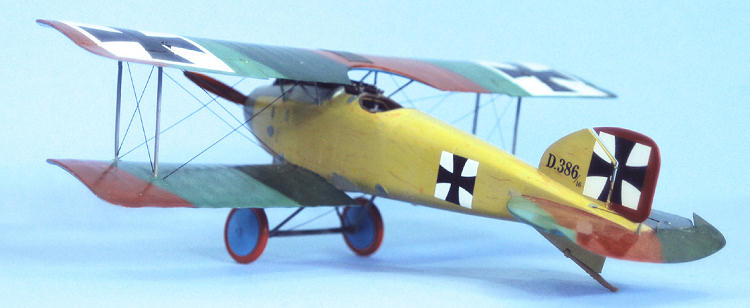
The Albatros series of fighters were the most advanced fighters in the
world at the time the D.I and D.II were introduced in 1916, setting the
parameters for the next 20 years: two 30 caliber machine guns, a high speed,
good maneuverability. The airplanes
were so advanced in comparison to their British opponents that they transformed
the air war on the Western Front.
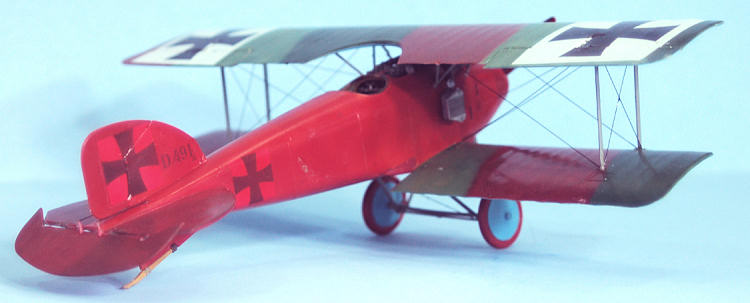
The D.I first appeared in the Spring of 1916, and entered combat on the
Western Front in limited numbers that summer.
Two major criticisms were leveled at the design as a result of this
combat experience: the “elephant ear” radiators on the sides of the fuselage
limited the pilot’s view ahead and down, which was dangerous both in combat and
when landing, and the wing was high enough that it limited the pilot’s view of
the upper hemisphere, which was dangerous in combat.
Albatros answered these problems with the D.II that summer, which first
lowered the upper wing to a position just above the pilot’s eye level, allowing
good forward view for weapon aiming and excellent upper view in combat.
While it initially appeared with the same cooling system as the D.I, the
D.II quickly changed the radiators from the fuselage to the upper wing, though
both systems were produced interchangeably through the first 100, which were the
original equipment of Jasta 2, the most famous Albatros unit of the war.
The Albatros foghter was a revelation to the Allies, who were primarily
equipped with the Nieuport 11 and deHavilland D.H.2, which were only starting to
be replaced by the Nieuport 17, a design that only bested the Albatros in
close-in man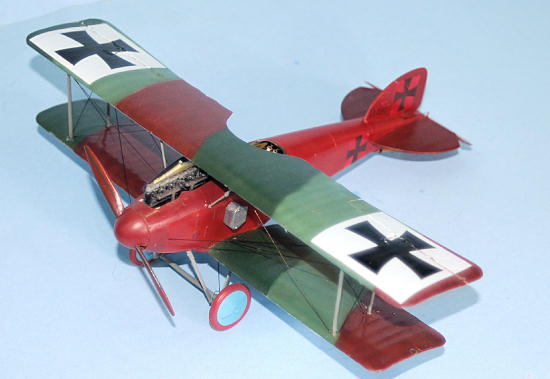 euverability,
being both outgunned and slower than the German fighter, which could thus
initiate and break off combat at will.
euverability,
being both outgunned and slower than the German fighter, which could thus
initiate and break off combat at will.
Both the D.I and the D.II were single-bay biplanes, which was the
configuration Albatros should have maintained for the entire series.
As a biplane, the design was strong and rugged, and a pilot could throw
the airplane through air combat maneuvers with abandon.
Unfortunately, Idflieg, the German Air Force high command, had
been taken by the success of the French Nieuport series of sesquiplanes that had
ended the “Fokker Scourge” in early 1916.
As a result, all German aircraft manufacturers were instructed to produce
sesquiplanes, no matter the fact that the design really only worked with a
low-powered, lightly-loaded airplane.
This was just what the Albatros wasn’t, but the company proceeded to
convert their very successful, heavy, highly-loaded, fast biplane to a
sesquiplane. This crippled the
design for the rest of its service through to the end of the war.
Boelcke and
Richtofen:
As opposed to the aristocratic von Richtofen, Oswald Boelcke was a son of
the middle classes. Born in 1891,
son of a schoolteacher, studious and athletic, Boelcke excelled at mathematics
and physics, and also took up swimming, tennis, rowing, and gymnastics. His
father was a German nationalist who admired Prussian and militarism.
Boelcke joined the army in 1913 and joined the Fliegertruppen as an NCO
pilot.
In 1915, Boelcke was transferred to the newly formed Aviation Section 62
at Döberitz, where he became one of the first pilots of the Fokker E. I
Eindekker. Flying the E.I Boelcke shot down
five enemy aircraft by the end of 1915. By early 1916, the Nieuport 11,
deHavilland D.H.2, and Vickers F.B.5 were giving the Germans trouble.
Boelcke developed tactics to counter them: accurate gunnery, tight
formations, and staying within the German lines.
In January, 1916, Boelcke downed four more airplanes, including a Vickers
F.B.5 "Gunbus." Unfamiliar with the
maneuverability of the F.B.5, It took 30 minutes of close-in air combat before
the British flier finally made his mistake over Boelcke's airdrome at
Douai,
and Boelcke shot him down. He was awarded the Pour le Mérite for this.
With the onset of the British
Somme
Offensive in July 1916, the Royal Flying Corps achieved air superiority over the
Germans through use of better tactics and overwhelming numbers used offensively,
with the Fokker Eindekker finally revealed as the obsole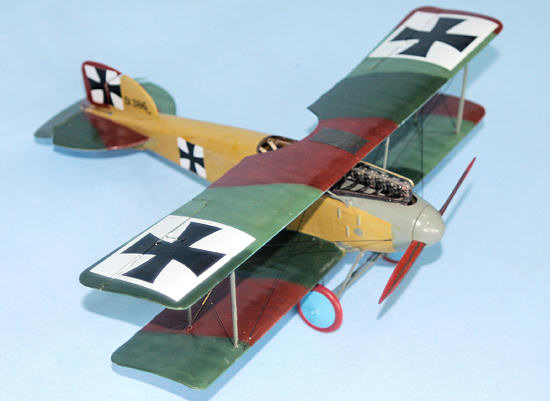 te
and ineffective fighter it had always been, once confronted with competent
adversaries. Boelcke was given the
opportunity to create a Jagdstaffel - a fighting squadron - unlike any in
German service before and modeled organizationally on the Allied fighter
squadrons with a single type of single-seater “scout” for the purpose of aerial
combat. He was allowed to recruit
pilots from throughout the Fliegertruppen for this elite unit.
te
and ineffective fighter it had always been, once confronted with competent
adversaries. Boelcke was given the
opportunity to create a Jagdstaffel - a fighting squadron - unlike any in
German service before and modeled organizationally on the Allied fighter
squadrons with a single type of single-seater “scout” for the purpose of aerial
combat. He was allowed to recruit
pilots from throughout the Fliegertruppen for this elite unit.
Manfred Albrecht, Freiherr von Richthofen, was born on
May 2, 1892
in the eastern German city of
Breslau.
His father, Major Albrecht von Richthofen, a minor a Prussian nobleman,
was retired from the Army. At age
11, Manfred was sent to the military school at Wahlstatt, and then to the
Royal
Military
Academy
at Lichterfelde. At graduation in April 1911, he was commissioned in the 1st
Regiment of Uhlans, Kaiser Alexander
III,
and was promoted to Leutnant in 1912.
After brief service in the trenches following the outbreak of a war in
which cavalry had no role, von Richtofen became an aerial observer, flying on
the Eastern Front. He met the famous Oswald Boelcke in August 1915, who advised
him to become a pilot.
Surprisingly, the future Ace of Aces was not a natural pilot, taking a
then-unheard-of 24 hours of dual instruction before he was judged capable of
solo on October 10, 1915 - this at a time when a pilot might solo with as few as
3-4 hours of dual training. He
returned to the Eastern Front and flew observation airplanes until the summer of
1916, when Boelcke - then traveling throughout the Army to recruit pilots for
the squadron he had been appointed to lead - stopped by. Boelcke remembered the
young ex-Uhlan and brought him along to form the original pilot
contingent of Jasta 2.
Boelcke’s unit, Jasta 2, was the first to be completely equipped
with the then-advanced Albatros D.I and D.II biplanes armed with two machine
guns, unlike the single weapon their opponents carried.
Trained with his rules of how a fighting unit should operate in the air,
the unit changed the air war.
Entering combat on
September 17, 1916,
Jasta 2 made its presence felt immediately.
Over the first month of combat, Boelcke scored an additional 11 victories
to bring his total to 40, making him the Ace of Aces.
Boelcke cared little for this, since his philosophy of air combat did not
promote the individual but rather the team:
"Everyt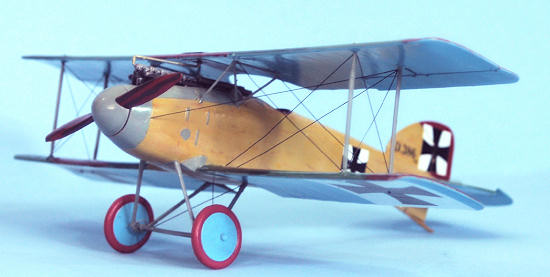 hing
depends on sticking together when the Staffel goes into battle. It does not
matter who actually scores the victory as long as the Staffel wins."
hing
depends on sticking together when the Staffel goes into battle. It does not
matter who actually scores the victory as long as the Staffel wins."
Richthofen scored on the first mission and within a month he had six
victories. Boelcke was killed in a
mid-air collision with one of his own men on October 28, 1916.
A bit less than a month later, Richtofen entered the history books with
the epic fight that ended with him shooting down Major Lanoe Hawker, V.C., the
leading British ace, for his eleventh victory.
Richtofen soon rose to command Jasta 2 and demonstrated himself
Boelcke’s star pupil. He came into
his own as the leading ace of the German air force when he bettered his
teacher’s score during the fighting of “Bloody April,” in 1917.
Shortly after his victory over Hawker, he began painting his airplanes
red, and was known as “der Rote Kampfflieger” by the Germans, “Le
Petit Rouge” by the French, and “The Red Baron” by the British.
Roden brought out their 1/32 Albatros D.III
a couple of years ago. This kit
differs from that earlier kit by the substitution of the biplane wings and
bracing struts that were used by the D.I.
The fabric effect on these wings is excellent, providing a very realistic
look. The fuselage - with is the
same as the D.III
- is fully detailed with a cockpit and engine compartment, while the Spandau
machine guns and Mercedes engine are beautifully molded and detailed.
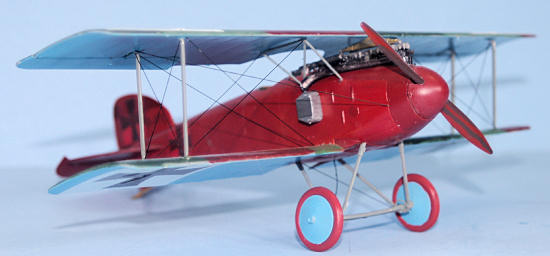 Decals are provided for four aircraft, including two that were in overall
green/brown/light blue camouflage, for those who doubt their ability to create a
natural wood finish for the fuselage.
Decals are provided for four aircraft, including two that were in overall
green/brown/light blue camouflage, for those who doubt their ability to create a
natural wood finish for the fuselage.
The rigging is simple enough on Albatros fighters that it should provide
no difficulty for someone trying their first biplane model.
The Encore Kits Albatros D.II is the D.I kit with shorter, white metal
interplane struts and a resin Mercedes D.III
engine, as well as a 1/32 resin figure of Oswald Boelcke.
Decals are provided for D.386, the late-version D.II flown by Boelcke,
and D.491, the early-version D.II flown by Richtofen.
I asked Roden for the sprues that included the later “N” struts of the
D.II and D.III,
which were kindly provided. This
allowed me to build both the Boelcke and Richtofen airplanes, using my D.I kit
and the Encore D.II kit.
As Kyle Bodily described it so well, the Roden Albatros, which ever
version, is a “fiddly” kit to assemble.
I found it advisable to assemble the interior structure with
cyanoacrylate glue, to insure proper positioning of the parts and solid
structure. Other than that, taking
the time to assemble things carefully will insure good results.
I regret not having photos of
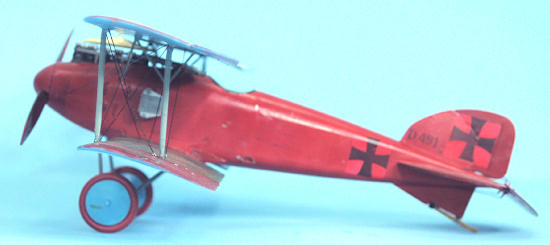 the
interior, but it turned out I needed to replace the camera batteries, as I
discovered when the photos taken of the early process didn’t turn out when
downloaded. I also found the Eduard
photoetch set, with its pre-painted seatbelts and instrument faces, made an
improvement on the interior.
the
interior, but it turned out I needed to replace the camera batteries, as I
discovered when the photos taken of the early process didn’t turn out when
downloaded. I also found the Eduard
photoetch set, with its pre-painted seatbelts and instrument faces, made an
improvement on the interior.
Getting the fuselage seam completely filled after assembling the fuselage
halves is extremely important since any remainder of the seam will be obvious
when one does a natural wood finish to the fuselage exterior.
I have concluded the best way to fill seams on limited-run kits (and
while they are well-produced, the Roden kits are closer to limited-run kits when
it comes to assembly than they are to Tamigawa kits) is to use cyanoacrylate
glue and let it dry on its own, resulting in a smooth surface that needs only a
minimum of sanding afterwards to get a smooth finish.
Once the fuselage was assembled, the rest of the assembly was easy.
I attached the horizontal stabilizer and lower wing, then proceeded with
painting.
Painting:
I created a “wood color” by mixing Gunze “Medium Wood” with Gunze
“Orange-Yellow” to get a honey-brown color.
I applied that to the interior before assembly, followed with a coat of
Tamiya “Clear Yellow” for the varnish.
I did the same with the exterior, with the addition of dry-brushing
thinned Tamiya “Hull Red” for the “wood grain effect” I wanted. The trick is to
use only a little dark color for the wood grain, which I accomplished with a
triple/zilch brush, cut blunt, and then the paint applied very dry brush; don’t
be afraid to go over any excess dark brown with the lighter color.
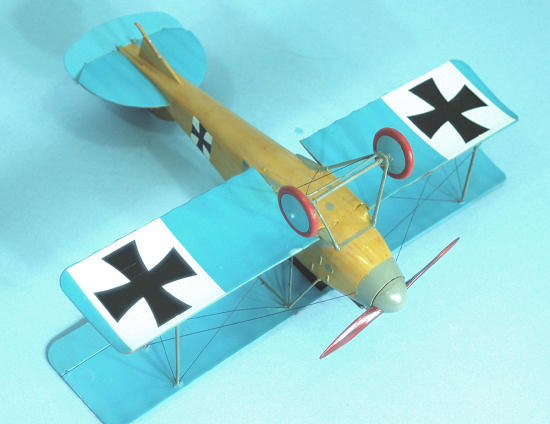 I painted the wings and horizontal stabilizer and the metal cowling,
masking them off before painting the wood effect on the fuselage.
I used Tamiya “Red Brown” and “Dark Green,” with some white applied to
the “Dark Green” for the lighter green color, for the upper camouflage colors,
and a mixture of Tamiya “Flat Blue” and “Flat White”for the lower surfaces.
I mixed some Tamiya “RLM Grey” with “Sky Grey” and “White” to get the
“greenish-grey color that was used on the Albatros, which was painted on the
cowling, the various inspection panels, the struts and landing gear; Tamiya “RLM
Grey” is really too dark, so it needs this mixture.
One could use Xtracrylix RLM Grey for this, since it is the right color.
I painted the wings and horizontal stabilizer and the metal cowling,
masking them off before painting the wood effect on the fuselage.
I used Tamiya “Red Brown” and “Dark Green,” with some white applied to
the “Dark Green” for the lighter green color, for the upper camouflage colors,
and a mixture of Tamiya “Flat Blue” and “Flat White”for the lower surfaces.
I mixed some Tamiya “RLM Grey” with “Sky Grey” and “White” to get the
“greenish-grey color that was used on the Albatros, which was painted on the
cowling, the various inspection panels, the struts and landing gear; Tamiya “RLM
Grey” is really too dark, so it needs this mixture.
One could use Xtracrylix RLM Grey for this, since it is the right color.
Once the Richtofen model was painted, I applied the decals, then when
they were set I applied a thinned coat of Gunze-Sangyo “Red 23" over the entire
fuselage, vertical fin and spinner.
This was done so the markings and the different colors beneath - wood, “greenish
grey” - would be visible and create different shades of red.
I applied Future overall to both models before applying decals. With the
Roden kit, I had to cut the white squares that are the background for the
national insignia from a sheet of white decal; the Encore kit has the national
insignia already printed on a white background.
Decals:
No problem with these decals.
They went down like champions under a coat of Micro-Sol.
I attached the interplane struts and the upper wing, then attached the
landing gear. The two airplanes
differ in their cooling systems, with the Richtofen airplane using the “ear”
radiators and the Boelcke airplane the wing radiator, which is done with the
photoetch parts provided in the Encore kit.
The rigging was done with .010 wire.
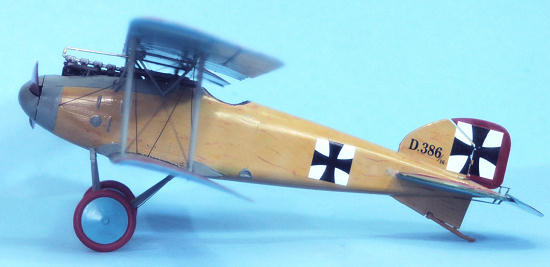 Oswald Boelcke is arguably one of the most important individuals in the
history of aerial warfare, for his development of the “Dicta Boelcke,” which has
formed the basic strategy for aerial combat by everyone everywhere ever since.
Manfred von Richtofen is arguably the most famous fighter pilot in
history. Having the two airplanes from the period when Boelcke the master passed
the torch to his student who then became the ultimate master, makes a great
addition to any collection of First World War airplanes.
While the kits are a bit tricky, there is nothing to the assembly that a
bit of patience and “some modeling skill required” cannot conquer, with a very
pleasing result.
Oswald Boelcke is arguably one of the most important individuals in the
history of aerial warfare, for his development of the “Dicta Boelcke,” which has
formed the basic strategy for aerial combat by everyone everywhere ever since.
Manfred von Richtofen is arguably the most famous fighter pilot in
history. Having the two airplanes from the period when Boelcke the master passed
the torch to his student who then became the ultimate master, makes a great
addition to any collection of First World War airplanes.
While the kits are a bit tricky, there is nothing to the assembly that a
bit of patience and “some modeling skill required” cannot conquer, with a very
pleasing result.
Richtofen kit courtesy Roden.
Boelcke kit courtesy my wallet.
Tom Cleaver
April 2010
If you would like your product reviewed fairly and quickly, please
contact
me or see other details in the
Note to
Contributors.
Back to the Main Page
Back to the Review
Index Page



 euverability,
being both outgunned and slower than the German fighter, which could thus
initiate and break off combat at will.
euverability,
being both outgunned and slower than the German fighter, which could thus
initiate and break off combat at will. te
and ineffective fighter it had always been, once confronted with competent
adversaries. Boelcke was given the
opportunity to create a Jagdstaffel - a fighting squadron - unlike any in
German service before and modeled organizationally on the Allied fighter
squadrons with a single type of single-seater “scout” for the purpose of aerial
combat. He was allowed to recruit
pilots from throughout the Fliegertruppen for this elite unit.
te
and ineffective fighter it had always been, once confronted with competent
adversaries. Boelcke was given the
opportunity to create a Jagdstaffel - a fighting squadron - unlike any in
German service before and modeled organizationally on the Allied fighter
squadrons with a single type of single-seater “scout” for the purpose of aerial
combat. He was allowed to recruit
pilots from throughout the Fliegertruppen for this elite unit. hing
depends on sticking together when the Staffel goes into battle. It does not
matter who actually scores the victory as long as the Staffel wins."
hing
depends on sticking together when the Staffel goes into battle. It does not
matter who actually scores the victory as long as the Staffel wins."
 the
interior, but it turned out I needed to replace the camera batteries, as I
discovered when the photos taken of the early process didn’t turn out when
downloaded. I also found the Eduard
photoetch set, with its pre-painted seatbelts and instrument faces, made an
improvement on the interior.
the
interior, but it turned out I needed to replace the camera batteries, as I
discovered when the photos taken of the early process didn’t turn out when
downloaded. I also found the Eduard
photoetch set, with its pre-painted seatbelts and instrument faces, made an
improvement on the interior. I painted the wings and horizontal stabilizer and the metal cowling,
masking them off before painting the wood effect on the fuselage.
I used Tamiya “Red Brown” and “Dark Green,” with some white applied to
the “Dark Green” for the lighter green color, for the upper camouflage colors,
and a mixture of Tamiya “Flat Blue” and “Flat White”for the lower surfaces.
I mixed some Tamiya “RLM Grey” with “Sky Grey” and “White” to get the
“greenish-grey color that was used on the Albatros, which was painted on the
cowling, the various inspection panels, the struts and landing gear; Tamiya “RLM
Grey” is really too dark, so it needs this mixture.
One could use Xtracrylix RLM Grey for this, since it is the right color.
I painted the wings and horizontal stabilizer and the metal cowling,
masking them off before painting the wood effect on the fuselage.
I used Tamiya “Red Brown” and “Dark Green,” with some white applied to
the “Dark Green” for the lighter green color, for the upper camouflage colors,
and a mixture of Tamiya “Flat Blue” and “Flat White”for the lower surfaces.
I mixed some Tamiya “RLM Grey” with “Sky Grey” and “White” to get the
“greenish-grey color that was used on the Albatros, which was painted on the
cowling, the various inspection panels, the struts and landing gear; Tamiya “RLM
Grey” is really too dark, so it needs this mixture.
One could use Xtracrylix RLM Grey for this, since it is the right color.
 Oswald Boelcke is arguably one of the most important individuals in the
history of aerial warfare, for his development of the “Dicta Boelcke,” which has
formed the basic strategy for aerial combat by everyone everywhere ever since.
Manfred von Richtofen is arguably the most famous fighter pilot in
history. Having the two airplanes from the period when Boelcke the master passed
the torch to his student who then became the ultimate master, makes a great
addition to any collection of First World War airplanes.
While the kits are a bit tricky, there is nothing to the assembly that a
bit of patience and “some modeling skill required” cannot conquer, with a very
pleasing result.
Oswald Boelcke is arguably one of the most important individuals in the
history of aerial warfare, for his development of the “Dicta Boelcke,” which has
formed the basic strategy for aerial combat by everyone everywhere ever since.
Manfred von Richtofen is arguably the most famous fighter pilot in
history. Having the two airplanes from the period when Boelcke the master passed
the torch to his student who then became the ultimate master, makes a great
addition to any collection of First World War airplanes.
While the kits are a bit tricky, there is nothing to the assembly that a
bit of patience and “some modeling skill required” cannot conquer, with a very
pleasing result.